Interieur 2012: Belgian designer Carl de Smet of Noumenon has developed high-tech foam furniture that can be squashed to 5% of its original size for easy transportation and then expanded "like popcorn" by heating it up (+ movie + interview).
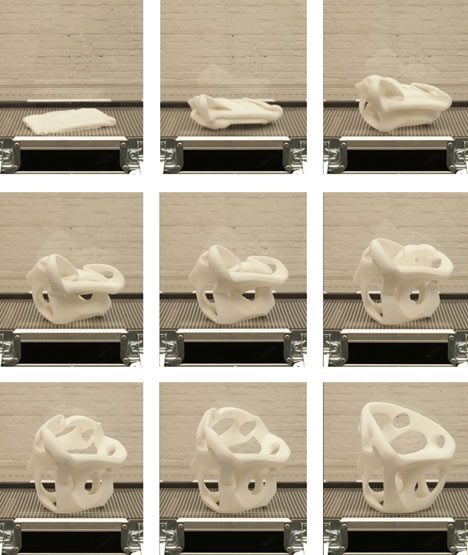
Under the proposal, which is still at the research stage, products made of polyurethane shape-memory polymers (SMPs) are compressed into flat, lightweight slabs (top left in the above sequence), meaning they take up very little space until they are required. When heated, the furniture returns to its original shape thanks to the "memory foam" properties of the material (see movie below).
"It's light, so for shipping it's almost taking up no space," de Smet told Dezeen. "If it gets damaged and it's heated again, [the damage] disappears. If you ship the packaging and something happens to it, it doesn't matter because it isn't the end product; that's in the imprinted memory."
The project evolved out of a research project to design a parabolic antenna for outer space that would be compressed to make a smaller payload on a spaceship, then expanded to full size when exposed to the sun's rays. This project involved shape-memory alloys (SMAs) - advanced metals that perform in the same way as SMPs, but which are highly expensive.
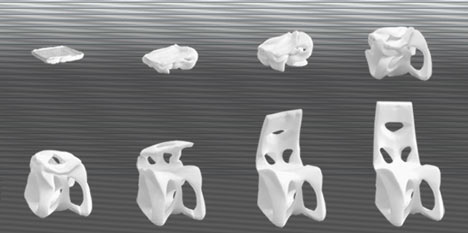
"I wanted to bring it back to daily life and not only use it for high technology projects, and for that the metals were too expensive," says de Smet. "With polymers, when you produce them in large quantities, it's affordable."
At the moment the items need to be placed in a large heated environment like a sauna to reach the required temperature of 70 degrees, but de Smet is researching other ways of triggering the transition from the compressed to the expanded form, for example by "programming" the material to return to its remembered form when electricity is passed through it.
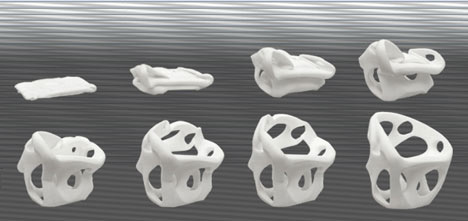
"[At the moment] it's programmed [to expand] at 70 degrees, because of the logistics of transport," de Smet said. "For example in the summer and the truck is stuck in traffic, then inside it is building up to 50 degrees and we don't want the furniture to pop, like popcorn."
The foam, which is strong enough to be structural, can be turned into furniture by milling solid blocks of the material or by injection moulding.
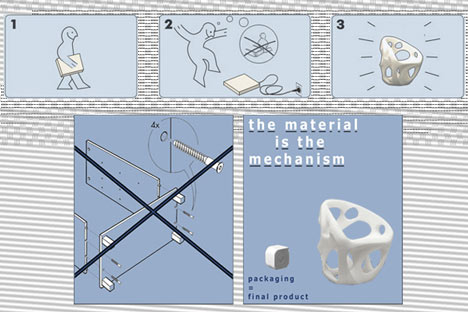
De Smet is exhibiting the project, including scale models of a foam armchair, at the Buda Factory building in Kortrijk, Belgium, as part of theInterieur 2012 design biennale. The exhibition continues until 28 October. See all our stories about Interieur 2012.
Below is the interview with de Smet, conducted by Dezeen editor-in-chief Marcus Fairs:
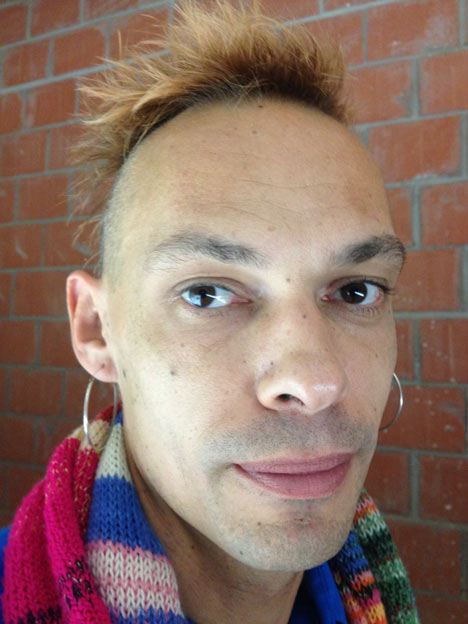
Marcus Fairs: Tell us about the Noumenon project.
Carl de Smet (above): It's a research project that started five, six years ago, around the world of smart materials, smart polymers, which have the possibility to change shape. It means you can fix a temporary shape and then if you reach a certain temperature it can transform into an end product.
Marcus Fairs: What kind of material is it? It looks like a kind of foam.
Carl de Smet: It's a kind of memory foam. Foam can have different densities; normal foam is really soft, spongy. But this one is rigid, so it's strong, which means you can us it as a structural support. And when it becomes hot and when it wants to change form, it becomes soft.
Marcus Fairs: Is this a material you invented yourself or one that you discovered and found a use for?
Carl de Smet: These polymers have been around for 20 years but finally we are updating the material for design applications on a bigger scale.
Marcus Fairs: Was this something you discovered by mistake?
Carl de Smet: We didn't discover it by mistake. In 2002/2003 I was doing a research project with shape-memory alloys; metals that are really well known. It was an idea to design a parabolic antenna for outer space. The idea was to bring a squeezed form out into space, connected to a spaceship. You unload it in the cold air then when you turn it to the sun the heat would open it and form an antenna. I really liked the idea of designing certain kinds of objects that have a performative behaviour. I wanted to bring it back to daily life and not only use it for high technology projects, and for that the metals were too expensive. As you know with polymers, when you produce them in large quantities, it's affordable. That's the reason I researched into plastics.
Marcus Fairs: So tell us how this could be used to create a product. Here you've got a model of an armchair.
Carl de Smet: It's an armchair but the basic idea is that [you buy it] in a packaging shape. You buy a package, you come home to the story that everybody knows now: the special key from Ikea; you put everything together; you assemble it yourself. Here the material is making this move. The material is doing the work. Because the form in imprinted in the memory effect of the material.
Marcus Fairs: So you manufacture this chair and you compress it, you squash it?
Carl de Smet: Yes.
Marcus Fairs: How much smaller can you make it than the original?
Carl de Smet: We can reduce it to 20 times smaller. If you think about the form it's a cellular structure, and inside the structure there is air and you can collapse this structure. Then it becomes like a slab.
Marcus Fairs: What's the benefit of this? I imagine you can ship it much more efficiently.
Carl de Smet: It's light, so for shipping it's almost taking up no space. If it gets damaged and it's heated again [the damage] disappears. If you ship the packaging and something happens it doesn't matter because it isn't the end product; that's in the imprinted memory.
Marcus Fairs: How do you then turn the squashed product into the full-sized product?
Carl de Smet: For the moment it's heat, but we are researching applications that will allow it to happen in households, because not everyone has a sauna at home where you can put furniture.
Marcus Fairs: So you have to put it in a very hot room?
Carl de Smet: At the moment it's programmed to [expand at] 70 degrees, because of the logistics of transport. For example in the summer if there is a traffic jam and the truck is stuck in traffic, then inside it is building up to 50 degrees and we don't want the furniture to pop, like popcorn. That's the reason we calculated 70 degrees. It sounds quite high but when you think about logistics, that's the minimum.
Marcus Fairs: How would you shape the product? With a mill?
Carl de Smet: It's made with a mill but we can also do injection moulding. This is a kind of a polyurethane, or PU. In the car industry the fake leather is made out of PU. So we can do it like fake leather or fake wood; it's just the finishing of the moulding process. It depends on the moulding and how you present it.
Marcus Fairs: What's the scientific process that allows it to retain its memory?
Carl de Smet: If you look under a microscope at polymers you see a kind of spaghetti form. In this form you make chemical cross-links and that fixes the form and the trigger. Every time you compress or stretch it it remembers the connection points and cross links.
http://www.dezeen.com/2012/10/25/noumenon-by-carl-de-smet/Published on Apr 5, 2013
Assembling your own furniture, after you have brought it home from the showroom, is a nightmare for many people.
So, what if flat-pack furniture was smart enough to assemble itself?
Belgian designer and engineer Carl de Smet is experimenting with a kind of smart foam technology, which he believes could do just that.
Once heated to a set temperature, the material he works with, shape memory polyurethane (SMPU), will expand to a given design.
Currently working with scaled-down models, de Smet is close to building the technology to achieve the effect with full-size furniture.
Ahead of its formal unveiling at the Milan Design Week festival on Tuesday, he gave BBC News a sneak preview at his Brussels studio.
http://www.noumenon.eu/#&panel1-1
So, what if flat-pack furniture was smart enough to assemble itself?
Belgian designer and engineer Carl de Smet is experimenting with a kind of smart foam technology, which he believes could do just that.
Once heated to a set temperature, the material he works with, shape memory polyurethane (SMPU), will expand to a given design.
Currently working with scaled-down models, de Smet is close to building the technology to achieve the effect with full-size furniture.
Ahead of its formal unveiling at the Milan Design Week festival on Tuesday, he gave BBC News a sneak preview at his Brussels studio.
http://www.noumenon.eu/#&panel1-1
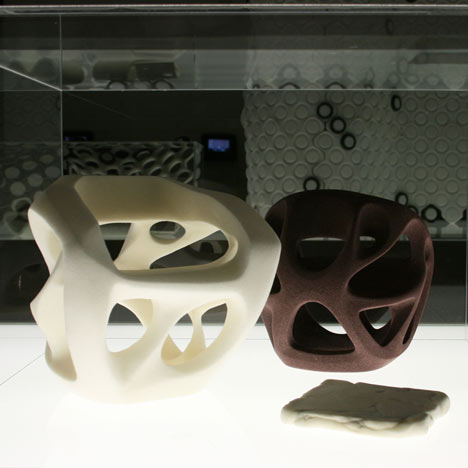
No comments:
Post a Comment